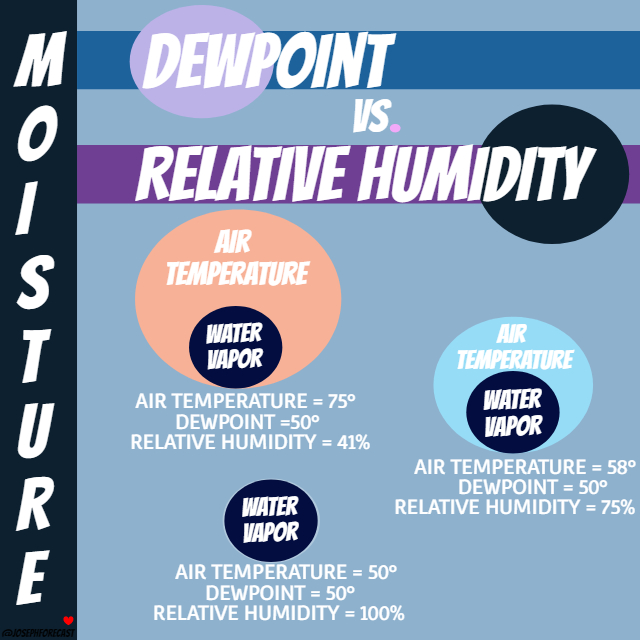Editor’s note: The KOIN 6 Weather team is presenting weather and science lessons to help serve our teachers and students. Click here for more lessons.
PORTLAND, Ore. (KOIN) – I would like to preface that this topic will carry you a long way in your weather studies. This is a concept that is overlooked and misunderstood across the board for many. With that said, it’s not a very difficult topic if it’s stripped down to just a few thoughts and images.

Today we are discussing the difference between dewpoint and relative humidity. For the record, dewpoint can be one or two words. I prefer one word, it just looks nice put together as a flowing unit. You can also refer to dewpoint as the dewpoint temperature. Why? The dewpoint is actually the number that represents the temperature that an air parcel must reach for saturation (the image/example below will clear any confusion). It is important to note that this is at constant pressure and water vapor.
With that being said, relative humidity is the representation of the amount of water vapor in the air compared to the total amount of vapor that can fill that parcel at a temperature. WHOA, that sounds a bit confusing, Joseph. Here is the deal, when we turn it into an image and bring up water balloons, it will make more sense.
NOW IS THE TIME TO CHECK THE IMAGE BELOW:

THOUGHT EXPERIMENT (image above):
My favorite example of this, in a simple way, is to think about water balloons.
We have three water balloons: One large red one, one medium blue balloon, one small transparent balloon (I’ve always preferred a medium-sized water balloon for more accuracy when throwing).
We have one cup of water for each balloon: We fill the large red balloon with one cup of water, the medium blue balloon with one cup of water and the transparent small balloon with one cup of water.
Explanation: Although your red balloon is the largest, it doesn’t actually have any more water than the other two balloons, right? On the other side of the coin, the small transparent balloon doesn’t have any more or less water than the other two although it may look like it. We filled each balloon with the same amount of water (one cup). Sure, you could fill the red balloon up with more water because it’s larger than the small one, but it only has the same amount as the other two. You can think of that one cup of water as the dewpoint. It’s the same one cup amount in each balloon (constant 50° in the image). You can think of the size of the balloon (red/large/75°, blue/medium/58°, transparent/small/50°) as the air temperature. You can then think of the space that is left in the balloon compared to the water as the relative humidity (41%, 75%, 100%).
Sure, that isn’t hard to understand. Proceed to the results.
Results: We know that the constant of 50° for the dewpoint is the better of the two measures for moisture for this purpose. Why? The number represents the moisture from each parcel, where the relative humidity number may feel misleading. For example, we know there isn’t anymore than one cup of water in that small transparent balloon, but the relative humidity is 100%. At night, when temperatures cool down, that parcel can be represented as smaller. The relative humidity level will make it look like it is VERY humid outside if you were to use relative humidity as your measurement of moisture. However, during the day when it warms to 75, it’s only 41%, which isn’t that humid. In conclusion, when the KOIN 6 weather team measures how sticky it “feels” outside, we use dewpoint to gauge that feeling.
Now this chart isn’t the rule of thumb for all, for it is slightly subjective to the person. In general, these dewpoint ranges are an examples of how it will feel to most people. The lower the dewpoint the drier it is, it will be more pleasant. You will start to feel the humidity once it pushes into the 60 degree range, before turning yucky in the 70s.

One reason that it is a treat to live in the Pacific Northwest is because the dewpoint levels don’t tend to get very high. We usually see those in the 50s during the summer, which is relatively dry. Why? Well that is for a future weather kids lesson.
